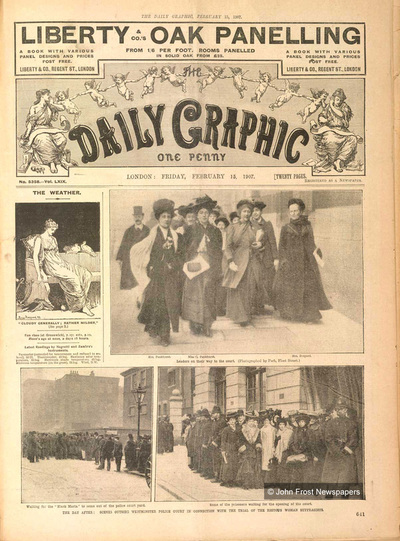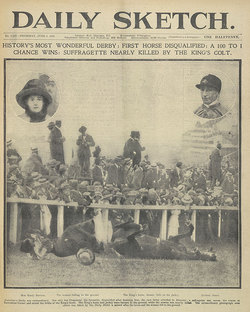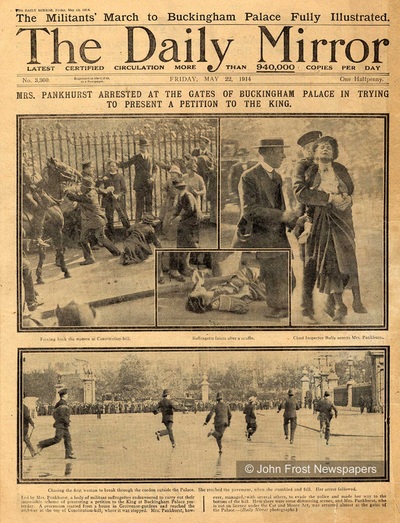Initial Actions
During the first decade of the twentieth century, suffragette action consisted mainly of disturbing political meetings and committing minor offenses: writing messages in public locations and stamping pennies with the slogan “Votes for Women.”
|
Hover for caption.
WSPU chalking the pavement, 1907, Suffragettes in Pictures |
“Volunteers are needed for pavement chalking. This is one of the most effective means of advertisement, as invariably an interested crowd assembles to watch the announcement . . . develop under the hand of the chalker.” |
Progression Towards Militant Strategies
As time passed, Pankhurst pushed the WSPU increasingly toward militant actions. Suffragettes began organizing massive marches, delivering speeches while chained to railings, protesting in front of Parliament, and even committing arson (after ensuring the building was unoccupied). Many were frequently arrested for their actions.
“Window-breaking when the Englishmen do it is regarded as an act of political opinion. Window-breaking when the Englishwomen do it is regarded as a crime.” |
Hover for caption.
Suffragettes demonstration in London, 1912, Illustration from Le pelerin |
“These women would go to politicians . . . and it didn't matter whether they were talking about the situation in Ireland or trade unions or the escalating war spread or trade policies. . . [the Suffragettes] would go 'you can’t do it without votes for women.' . . . A politician couldn't go anywhere now without a woman heckling."
– Barbara Winslow, Personal Interview
|
Hover for captions.
1. Police and Pankhurst Family, 1914, Bettmann 2. Emmeline Pankhurst Leading March Through Rain, 1915, Underwood & Underwood 3. Suffragette Arrested at Buckingham Palace, The Guardian, 1914 4. Suffragette March, 1910, Hulton-Deutsch Collection 5.Suffragettes Set Fire to Bath Hotel, 1914, BBC News |
"If they will not give us a hearing, we shall get inside the hall and make them.“ “Some of the women rushed at the gate and railings and climbed on to the crossbars, while others attacked the police and tried to force them out of the way." |
The Militancy's Impact
Although militant actions were highly controversial, the WSPU, under Pankhurst, undoubtedly succeeded in gaining recognition.
"[Militancy] raised the profile of the demand for the vote, ensured it reached a wider audience and pushed it to the top of the political agenda."
– Dr. Diane Atkinson, Personal Interview
|
Hover for caption. Click to enlarge.
Daily Graphic, 1907 |
Hover for caption. Click to enlarge.
Daily Sketch, 1913 |
Hover for caption. Click to enlarge.
Daily Mirror, 1914 |
“[Militancy] was absolutely imperative. That was the only way that a newspaper – anybody – would listen to the women
. . . the tactic of militancy by the WSPU woke Britain up to women’s suffrage.”
– Barbara Winslow, Personal Interview




